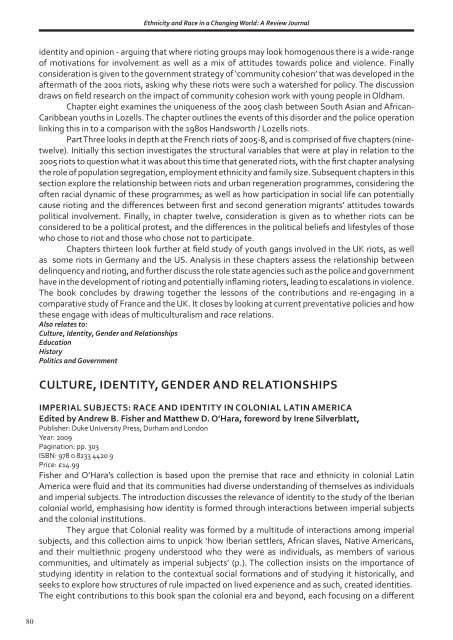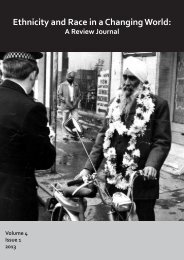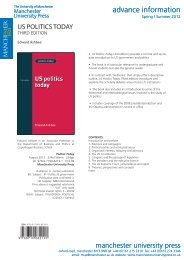Ethnicity and Race in a Changing World
Volume 2, Issue 1, 2011 - Manchester University Press
Volume 2, Issue 1, 2011 - Manchester University Press
You also want an ePaper? Increase the reach of your titles
YUMPU automatically turns print PDFs into web optimized ePapers that Google loves.
<strong>Ethnicity</strong> <strong>and</strong> <strong>Race</strong> <strong>in</strong> a Chang<strong>in</strong>g <strong>World</strong>: A Review Journalidentity <strong>and</strong> op<strong>in</strong>ion - argu<strong>in</strong>g that where riot<strong>in</strong>g groups may look homogenous there is a wide-rangeof motivations for <strong>in</strong>volvement as well as a mix of attitudes towards police <strong>and</strong> violence. F<strong>in</strong>allyconsideration is given to the government strategy of ‘community cohesion’ that was developed <strong>in</strong> theaftermath of the 2001 riots, ask<strong>in</strong>g why these riots were such a watershed for policy. The discussiondraws on field research on the impact of community cohesion work with young people <strong>in</strong> Oldham.Chapter eight exam<strong>in</strong>es the uniqueness of the 2005 clash between South Asian <strong>and</strong> African-Caribbean youths <strong>in</strong> Lozells. The chapter outl<strong>in</strong>es the events of this disorder <strong>and</strong> the police operationl<strong>in</strong>k<strong>in</strong>g this <strong>in</strong> to a comparison with the 1980s H<strong>and</strong>sworth / Lozells riots.Part Three looks <strong>in</strong> depth at the French riots of 2005-8, <strong>and</strong> is comprised of five chapters (n<strong>in</strong>etwelve).Initially this section <strong>in</strong>vestigates the structural variables that were at play <strong>in</strong> relation to the2005 riots to question what it was about this time that generated riots, with the first chapter analys<strong>in</strong>gthe role of population segregation, employment ethnicity <strong>and</strong> family size. Subsequent chapters <strong>in</strong> thissection explore the relationship between riots <strong>and</strong> urban regeneration programmes, consider<strong>in</strong>g theoften racial dynamic of these programmes; as well as how participation <strong>in</strong> social life can potentiallycause riot<strong>in</strong>g <strong>and</strong> the differences between first <strong>and</strong> second generation migrants’ attitudes towardspolitical <strong>in</strong>volvement. F<strong>in</strong>ally, <strong>in</strong> chapter twelve, consideration is given as to whether riots can beconsidered to be a political protest, <strong>and</strong> the differences <strong>in</strong> the political beliefs <strong>and</strong> lifestyles of thosewho chose to riot <strong>and</strong> those who chose not to participate.Chapters thirteen look further at field study of youth gangs <strong>in</strong>volved <strong>in</strong> the UK riots, as wellas some riots <strong>in</strong> Germany <strong>and</strong> the US. Analysis <strong>in</strong> these chapters assess the relationship betweendel<strong>in</strong>quency <strong>and</strong> riot<strong>in</strong>g, <strong>and</strong> further discuss the role state agencies such as the police <strong>and</strong> governmenthave <strong>in</strong> the development of riot<strong>in</strong>g <strong>and</strong> potentially <strong>in</strong>flam<strong>in</strong>g rioters, lead<strong>in</strong>g to escalations <strong>in</strong> violence.The book concludes by draw<strong>in</strong>g together the lessons of the contributions <strong>and</strong> re-engag<strong>in</strong>g <strong>in</strong> acomparative study of France <strong>and</strong> the UK. It closes by look<strong>in</strong>g at current preventative policies <strong>and</strong> howthese engage with ideas of multiculturalism <strong>and</strong> race relations.Also relates to:Culture, Identity, Gender <strong>and</strong> RelationshipsEducationHistoryPolitics <strong>and</strong> GovernmentCULTURE, IDENTITY, GENDER AND RELATIONSHIPSIMPERIAL SUBJECTS: RACE AND IDENTITY IN COLONIAL LATIN AMERICAEdited by Andrew B. Fisher <strong>and</strong> Matthew D. O’Hara, foreword by Irene Silverblatt,Publisher: Duke University Press, Durham <strong>and</strong> LondonYear: 2009Pag<strong>in</strong>ation: pp. 303ISBN: 978 0 8233 4420 9Price: £14.99Fisher <strong>and</strong> O’Hara’s collection is based upon the premise that race <strong>and</strong> ethnicity <strong>in</strong> colonial Lat<strong>in</strong>America were fluid <strong>and</strong> that its communities had diverse underst<strong>and</strong><strong>in</strong>g of themselves as <strong>in</strong>dividuals<strong>and</strong> imperial subjects. The <strong>in</strong>troduction discusses the relevance of identity to the study of the Iberiancolonial world, emphasis<strong>in</strong>g how identity is formed through <strong>in</strong>teractions between imperial subjects<strong>and</strong> the colonial <strong>in</strong>stitutions.They argue that Colonial reality was formed by a multitude of <strong>in</strong>teractions among imperialsubjects, <strong>and</strong> this collection aims to unpick ‘how Iberian settlers, African slaves, Native Americans,<strong>and</strong> their multiethnic progeny understood who they were as <strong>in</strong>dividuals, as members of variouscommunities, <strong>and</strong> ultimately as imperial subjects’ (p.). The collection <strong>in</strong>sists on the importance ofstudy<strong>in</strong>g identity <strong>in</strong> relation to the contextual social formations <strong>and</strong> of study<strong>in</strong>g it historically, <strong>and</strong>seeks to explore how structures of rule impacted on lived experience <strong>and</strong> as such, created identities.The eight contributions to this book span the colonial era <strong>and</strong> beyond, each focus<strong>in</strong>g on a different80






